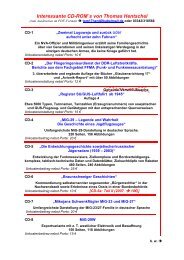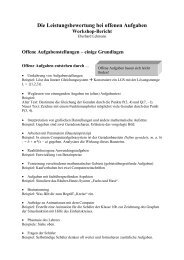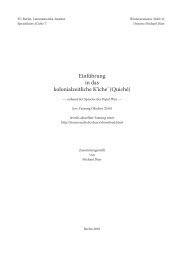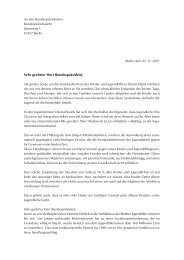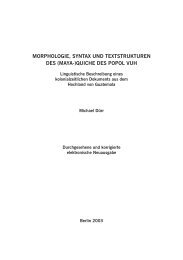SHADOW BOXING: INDONESIAN WRITERS ... - home . snafu . de
SHADOW BOXING: INDONESIAN WRITERS ... - home . snafu . de
SHADOW BOXING: INDONESIAN WRITERS ... - home . snafu . de
You also want an ePaper? Increase the reach of your titles
YUMPU automatically turns print PDFs into web optimized ePapers that Google loves.
170 Marshall Clark<br />
A young couple were riding on their bikes<br />
Roaming very very far<br />
After three <strong>de</strong>ca<strong>de</strong>s and two years<br />
That was the end of the story about that guy Dasamuka. 48<br />
Cheerfully referring to the end of Suharto's thirty-two years as presi<strong>de</strong>nt of Indonesia,<br />
this poem is testament enough to the wi<strong>de</strong>spread conceptualization, and<br />
representation, of Suharto as a latter-day Rahwana/Dasamuka. T-shirts <strong>de</strong>signed and<br />
printed in Solo early in 1998, 49 <strong>de</strong>picting a caricature of Rahwana strongly resembling<br />
Suharto as the gaoler of the many missing stu<strong>de</strong>nt activists at the time, also reinforced<br />
the image of the Presi<strong>de</strong>nt as an "evil kidnapper/' intent on thwarting the stu<strong>de</strong>nt-led<br />
reformasi movement.<br />
A similar theme was <strong>de</strong>veloped at the same time by Soebadio Sastrosatomo, the<br />
aged Sukarno-era socialist lea<strong>de</strong>r and author of Politik Dosomuko Rezίm Or<strong>de</strong> Baru<br />
(1998). Soebadio's book, which is based on a humorless reading of the Ramayana's<br />
oppositional conflict between Dasamuka and the monkey army, un<strong>de</strong>niably represents<br />
Suharto as Dasamuka and the monkeys as ordinary Indonesians. Throughout the<br />
twenty-three pages of Politik Dosomuko, Soebadio is scathing in his attack on Suharto's<br />
"evil" rule, claiming that throughout Suharto's presi<strong>de</strong>ncy the Indonesian people were<br />
harshly oppressed. The dominant motif of Soebadio's highly polemical text is based<br />
upon the conceit that Suharto began and continued his rule of Indonesia in the same<br />
manner as Dasamuka had done in Alengka. Un<strong>de</strong>r the heading "Dosomuko's Political<br />
System," Soebadio bitterly claims that Dasamuka's ten faces represent ten aspects of<br />
Suharto's regime: the eradication of the rakyat's sovereignty; the manipulation of the<br />
Pancasila as a means of political control; the neutralization of the legal system; the<br />
repression of political parties and workers' unions; the emasculation of the parliament;<br />
the censorship of the mass media; the <strong>de</strong>velopment of an economy rife with nepotism,<br />
corruption, and collusion; the <strong>de</strong>-intellectualization of the education system; the<br />
standardization of culture; and the violation of basic human rights. 50<br />
Marc Perlman has observed that Soebadio's "blistering" comparison between<br />
Dasamuka and Suharto's regime would do many a dalang proud. 51 Significantly, Politik<br />
Dosomuko appeared in February 1998, and was banned and withdrawn from sale on<br />
April 22 of the same year, in the month before Suharto's resignation. 52 This shows how<br />
seriously, and personally, such writing was taken by the Presi<strong>de</strong>nt, confirming the<br />
remarks of a nineteenth-century editor of Aesop: "A tyrant cannot take notice of a<br />
48<br />
Dua sejoli bersepeda<br />
Jauh di sana berkelana<br />
Usia tridasa dwiwarsa<br />
Tamat lakon si-Dasamuka. S. Maharani, Minggu Pagi 51,8 (July 1998).<br />
49<br />
My thanks to Helen Pausacker, who was living in Solo at the time, for showing me one of these T-shirts.<br />
5^ Soebadio Sastrosatomo, Politik Dosomuko Rezim Or<strong>de</strong> Baru, pp. 3-4.<br />
51<br />
Marc Perlman, 'The Traditional Javanese Performing Arts in the Twilight of the New Or<strong>de</strong>r: Two<br />
Letters from Solo/ 7 Indonesia 68 (October 1999): 25.<br />
52<br />
See "Buku Tolitik Dosomuko 7 Karya Soebadio Dilarang," Kompas, May 8,1998; and "Soebadio<br />
Sastrosatomo Tutup Usia," Kompas, December 8,1998.


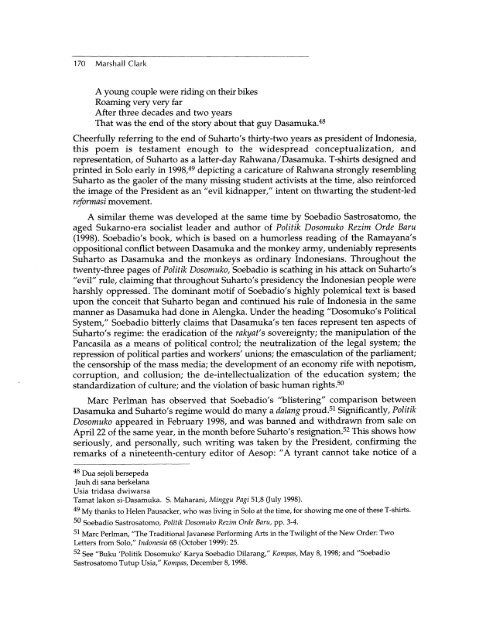
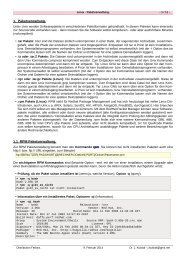
![Parameterdarstellungen [ x(t), y(t) ] Eberhard ... - home . snafu . de](https://img.yumpu.com/22517728/1/184x260/parameterdarstellungen-xt-yt-eberhard-home-snafu-de.jpg?quality=85)
